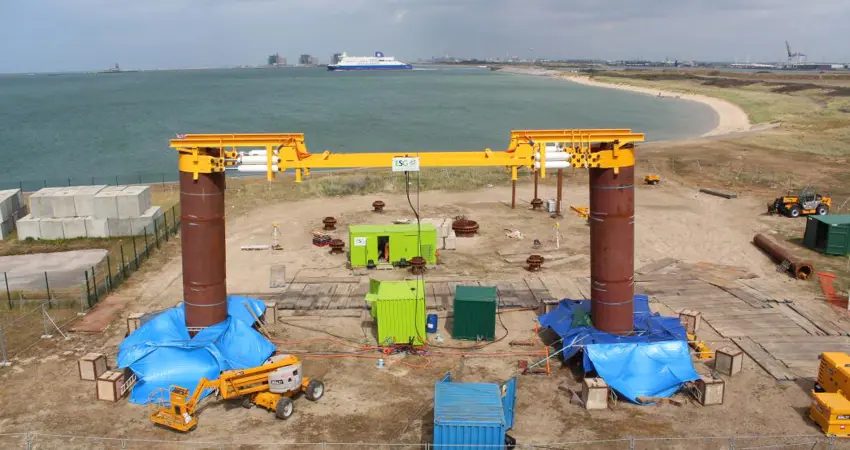27 Apr 2020
New design methods could bring ‘significant’ savings for offshore wind industry
PISA project’s research now publicly available for use in new wind farm developments

Credit: Carbon Trust
Research from the award-winning Pile Soil Analysis (PISA) project has detailed new, industry-specific guidance to model the interactions between offshore wind turbine monopile foundations and clay and sand seabed conditions. The £3.5 million joint industry research project was led by Ørsted and run through the Carbon Trust’s Offshore Wind Accelerator programme. Academic input was led by the Department of Engineering Science at Oxford, alongside Imperial College London and University College Dublin.
Successful field-testing validation of the bespoke new design methods suggests that previous approaches under-estimate the support that the seabed soil provides to the foundation, resulting in over-conservative design calculations for monopiles. More accurate methods devised by the PISA project are estimated to have the potential to reduce steel requirements for foundations by up to 30 percent for some design conditions, realising significant cost savings.
The PISA project is a fantastic example of industry and academia working closely together to solve engineering problems of real significance to the offshore wind industry.
The research papers detailing the research findings are now available Open Access from the Géotechnique journal by ICE Publishing.
Professor of Engineering Science Byron Byrne, Principal Investigator for the PISA project says,
“The PISA project is a fantastic example of industry and academia working closely together to solve engineering problems of real significance to the offshore wind industry. I am pleased to see that all eight papers are now available Open Access through Géotechnique. Dissemination of the work in this way facilitates a wider and more rapid uptake of the new knowledge, not only for wind farm design by the industry but also as a basis for new research initiatives in academia.”
Previous estimates for the behaviour of wind turbine foundations were based on offshore oil and gas platform design methods, where the foundation piles are smaller in diameter, longer and must resist different loading conditions during use. The new design methods specifically address larger diameter monopile geometries, as well as wind turbine loading conditions, to allow bespoke optimisation of turbine foundations and structures for specific geographic locations.
The field testing, which provided the validation data for the new design model, was undertaken in two locations with characteristics similar to those found in the North Sea; clay conditions at Cowden UK; and sand conditions at Dunkirk, France. The new knowledge is now publicly available for use by the offshore wind industry to bring forward new wind farm developments, as demonstrated by Ørsted, who have applied the new methods to their Hornsea windfarm.
Ørsted’s Technical Manager Miguel Pacheco Andrade explains the value of the PISA project for the offshore wind industry: “The PISA framework is now routinely used in design by all major players in the offshore wind power industry, leading to even more efficient and cost effective monopile foundations for offshore wind farms across the globe. The use of the PISA methodology represents a major paradigm shift in offshore geotechnical design. Not only has it led to significant steel savings for monopile foundations, but the use of PISA allows greater confidence in our design calculations.”
Jan Matthiesen, Director, Offshore Wind, the Carbon Trust, commented: “We believe these new methodologies will have a significant impact on the way industry understands the interaction between soil conditions and monopile foundations. It is the culmination of many years of collaborative work between industry and academia. Replacing models which were originally developed for the oil and gas sector is a critical step in reducing costs even further.”
The eight PISA papers are now available on Open Access from the Géotechnique journal on the Institution of Civil Engineers’ website www.icevirtuallibrary.com and at the following links:
PISA#1 Site Characterisation https://doi.org/10.1680/jgeot.18.PISA.001
PISA#2 Field testing methods https://doi.org/10.1680/jgeot.18.PISA.002
PISA#3 Field testing in glacial clay till at Cowden https://doi.org/10.1680/jgeot.18.PISA.003
PISA#4 Field testing in marine sand at Dunkirk https://doi.org/10.1680/jgeot.18.PISA.004
PISA#5 Finite element modelling for glacial clay till https://doi.org/10.1680/jgeot.18.PISA.005
PISA#6 Finite element modelling for marine sand https://doi.org/10.1680/jgeot.18.PISA.006
PISA#7: PISA design model for glacial clay till https://doi.org/10.1680/jgeot.18.P.255
PISA#8: PISA design model for marine sand https://doi.org/10.1680/jgeot.18.P.277
PISA#9: Application of the PISA design model to monopiles embedded in layered soils https://doi.org/10.1680/jgeot.20.PISA.009
The PISA project received technical input and funding support from former Alstom (now GE Renewable Energy), EDF renewables, E.ON (now RWE), Equinor, Iberdrola, innogy, Ørsted, SSE, Statkraft, Van Oord and Vattenfall.




